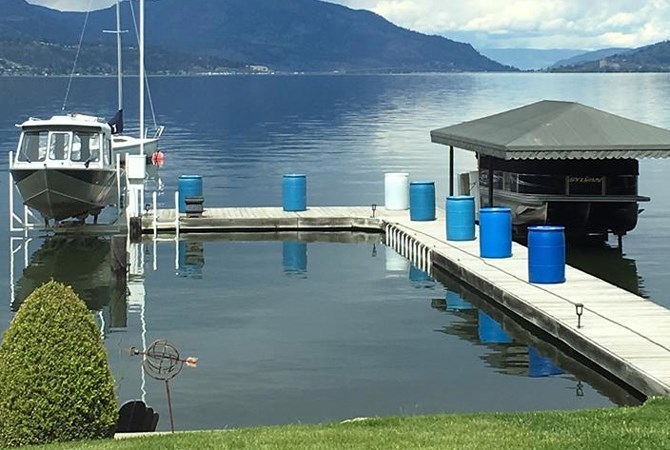
Experts recommend adding weight to docks to keep them from floating off pilings.
Image Credit: Judy Proskiw
May 17, 2017 - 4:37 PM
OKANAGAN – Waterfront property owners across the Okanagan are keeping a close eye on lake levels, and those with docks are especially nervous.
Yanek Buksowicz is owner of Paradise Dock and Lift. For nine years he's been building and servicing docks and lifts across B.C. He says some of his customers are “kind of panicking lately."
Okanagan Lake is already spilling its banks in parts of Kelowna and West Kelowna, and since Monday, May 15, has risen more than 2.5 centimetres to 342.7 metres above sea level, according to the Central Okanagan Emergency Operations. If it reaches 343.6 m, extensive flooding is likely.
Buksowicz tells his worried customers to add as much weight as possible to their docks to keep from lifting off their pilings, and he has some other tips to minimize possible damage as well. Sand and bags are available at sites across the Okanagan but many dock owners prefer the convenience of water-filled barrels. Metal barrels can leave permanent rust stains on wood so plastic is the preferred choice.
“A lot of docks want to float so that puts a lot of strain on the metal strapping that holds them in place,” he says. “The more (weight) you can get on there the better, there’s no real science to it.”

Lake Country resident Willard Turner lives on the shore of Ellison Lake. He says this is already the highest the water has been since he moved here in the early 1990s.
(ADAM PROSKIW / iNFOnews.ca)
Buksowicz recommends shutting off power to lifts, lights and outlets, and removing electric motors.
“Some are even taking dock boards out so when you get a surge it’s got somewhere to go,” he says. “If you’re really concerned about it, take every third board out or one of every four.”
Owners that live in areas with high wind, wave or boat traffic should take their boats off the lifts until the lake level drops back down.
“Remove the boat from the lake and put it on the trailer,” he says. “You have to make a judgement based on how high the keel is from the lake and depending where it is on the lake. In rougher areas you want to be higher than in some other areas that are more protected."
To establish how flood levels will impact your property, the Central Okanagan Regional District recommends measuring and marking 90 cm above the current water level. This mark indicates the projected high water mark in the coming weeks, as well as a small buffer space and is how high flood protection needs to be.
The Regional District also recommends owners of anchored boats ensure long enough lines, docks be raised as high as possible and all loose items removed for areas at risk of flood.
Find more information about spring flooding here.
The latest updates from the Central Okanagan Emergency Operations Centre are available here.
To contact a reporter for this story, email Adam Proskiw or call 250-718-0428 or email the editor. You can also submit photos, videos or news tips to the newsroom and be entered to win a monthly prize draw.
We welcome your comments and opinions on our stories but play nice. We won't censor or delete comments unless they contain off-topic statements or links, unnecessary vulgarity, false facts, spam or obviously fake profiles. If you have any concerns about what you see in comments, email the editor in the link above.
News from © iNFOnews, 2017